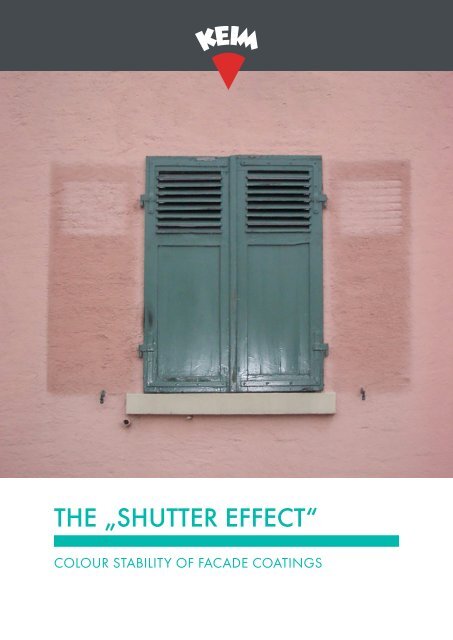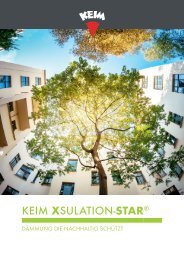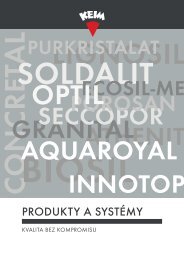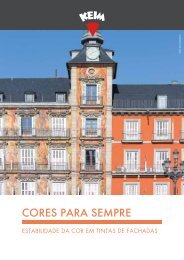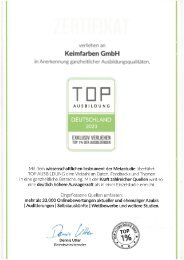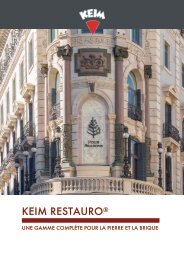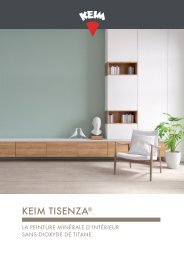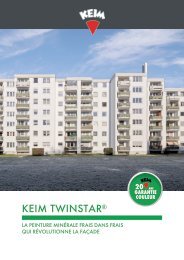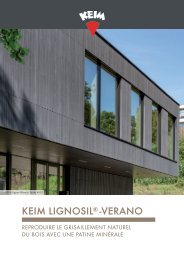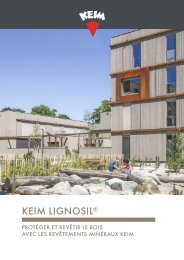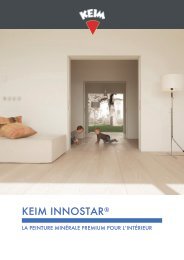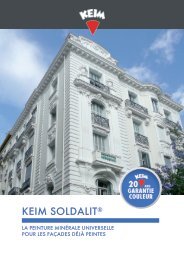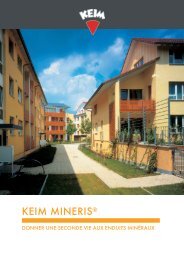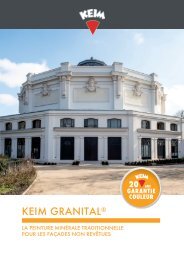KEIM "The shutter effect"
- No tags were found...
You also want an ePaper? Increase the reach of your titles
YUMPU automatically turns print PDFs into web optimized ePapers that Google loves.
THE „SHUTTER EFFECT“<br />
COLOUR STABILITY OF FACADE COATINGS
REMA
COLOURS<br />
IN COLOURFUL<br />
Colours change: Wood becomes grey, white coatings turn yellowish and facades fade.<br />
How obvious colours can change show individual areas of a facade that were in the shade like for<br />
example behind <strong>shutter</strong>s. <strong>The</strong> problem of exposed and unexposed surfaces lying next to each other<br />
and showing changed and unchanged colour shades, can be solved. With paints from <strong>KEIM</strong>!
T H E "SHUTTER EFFECT" – COL O U R ST A B I L I T Y OF F A C A D E CO A T I N G S<br />
5<br />
COLOUR STABILITY –<br />
A NEGLECTED QUALITY FEATURE<br />
PAINT IS A DESIGN ELEMENT<br />
Paint is multi-functional: It protects the structure on<br />
one hand, and serves as important design medium in<br />
architecture and urban planning on the other hand.<br />
Investment in the proper paint material and colour<br />
design will pay off, because paint is the most inexpensive<br />
and most effective design element for a building.<br />
One-family house or residential complex, administration<br />
or public building, individual building or entire<br />
streets, well thought out colour concepts enhance<br />
perceptibly the living quality und well-being of the<br />
users. <strong>The</strong>y provide orientation and identity, increase<br />
values and express oftentimes an attitude to life.<br />
SHUTTER EFFECT<br />
As we all know, nothing lasts forever. Colours change<br />
also, sometimes faster sometimes slower, by soiling,<br />
pollutants and of course the UV component in the sunlight.<br />
Colour shade changes of exterior paint coatings<br />
are a visual shortcoming and visible to everyone.<br />
A typical picture is the so-called “<strong>shutter</strong> effect”:<br />
<strong>The</strong> facade has faded but only behind the <strong>shutter</strong>s,<br />
where the wall is protected from sunlight and weather,<br />
you can find the original colour still largely unaltered.<br />
This and many other phenomena disrupt the overall<br />
impression of a facade severely. Not only are they<br />
unattractive, but also ruin any colour design.<br />
PAINT QUALITY IS DECISIVE<br />
Incomprehensible that colour fastness of paint products<br />
as a quality concern does not call for more attention.<br />
<strong>The</strong>re is certainly no such thing as a hundred percent<br />
colour shade stability, but the differences in quality and<br />
behaviour of paint materials are tremendous. <strong>The</strong>re are<br />
indeed coatings whose colour shade remain over<br />
decades unchanged for the human eye! It is, of course,<br />
quite true that there is barely a commercial coating<br />
product which is not promoted as being “UV resistant”,<br />
“lightfast” or “colour stable”. But, not all paints are<br />
equal. What are the differences?<br />
INFLUENCE FACTORS ON<br />
COLOUR CONSTANCY<br />
Colour stability and a constant visual impression over<br />
the long term are determined by a series of different<br />
factors. While the soiling tendency or the self-cleaning<br />
effect of coatings depend on the binding agent, result<br />
other impacts in changes of the “inner values” of a<br />
coating. For example, when the binder disintegrates<br />
occur microcracks that impair the light refraction and<br />
the colour shade of the coating appears grey and<br />
milky. Also the pigments themselves become stressed<br />
when exposed to UV light: <strong>The</strong>y change their chemical<br />
structure and thus their colour.<br />
UV LIGHT<br />
AIR<br />
POLLUTANTS<br />
PIGMENTS<br />
WEATHERING<br />
BINDER<br />
FILLERS<br />
ADDITIVES<br />
COLOUR<br />
UV LIGHT<br />
COLOUR SHADE CONSTANCY<br />
COLOUR STABILITY<br />
DIRT, ALGAE,<br />
FUNGI
MINERAL PIGMENTS:<br />
RESISTANT AGAINST UV LIGHT<br />
AND AIR POLLUTANTS<br />
<strong>KEIM</strong> mineral paints are formulated with solely highly light-resistant, inorganic pigments providing a colourfulness that is stable over decades.<br />
THERE ARE TWO TYPES OF PIGMENT<br />
Colouring pigments may be divided into organic<br />
and inorganic (mineral) pigments. <strong>The</strong> differences<br />
in the materials on which they are based result in<br />
differences in resistance between the two categories<br />
of pigments.<br />
UV radiation can cause colour changes in pigments.<br />
This phenomenon is familiar from textiles: items of<br />
clothing which have been hung on outdoor display<br />
racks exposed to sunlight often have faded areas.<br />
Exterior wall coatings can suffer a similar fate if<br />
UV resistant pigments have not been added to<br />
the paint or have not been added in sufficient<br />
quantity. In the same way that citric acid removes<br />
organic dyes in fruit stains, cause aggressive<br />
atmospheric pollutants ("acid rain") colour changes<br />
in organic pigments.<br />
Mineral pigments, however, are acid-resistant and<br />
excel by an outstanding high colour fidelity and<br />
lightfastness because the chemical structure of their<br />
powder form is stable against external influences.<br />
Thus, mineral paints remain almost unchanged over<br />
decades and plus, they sparsely attract dirt particles.<br />
In brief:<br />
Mineral pigments convince<br />
with highest light and<br />
UV resistance and keep their<br />
colourfulness over decades.
T H E "SHUTTER EFFECT" – COL O U R ST A B I L I T Y OF F A C A D E CO A T I N G S<br />
7<br />
MINERAL BINDERS:<br />
RESISTANT TO UV LIGHT<br />
AND WEATHERING<br />
Top: Already after 2 years of weathering, this organically bound<br />
coating shows microcracks and spalling in the initially intact coating<br />
layer.<br />
Left: <strong>The</strong> binder is the most important, quality-determining component<br />
of a paint. It ensures the bond of the different ingredients and, above<br />
all, the adhesion of the paint to the substrate.<br />
NOT ALL PAINTS ARE EQUAL<br />
Good paint material depends on the binding agent.<br />
It holds the coating together, is decisive for the<br />
coating properties and renovation cycles of a facade.<br />
UV resistance and weather fastness of the binder<br />
also play an important part in the colour stability of<br />
the finished coating. Like pigments, paint binders can<br />
also be divided into two fundamental directions:<br />
<strong>The</strong> mineral or the petrochemical technology.<br />
– Organic binders, such as synthetic resin<br />
dispersions including silicone resin emulsions<br />
or dispersions and,<br />
– Inorganic (mineral) binders, such as water glass<br />
(potassium silicate) or sol-silicate (silica-sol water<br />
glass mixture)<br />
Organic binders are manufactured on the basis of<br />
polymers, meaning synthetics which are produced<br />
from crude oil in energy-intensive synthesis processes.<br />
<strong>The</strong> binding agent particles are the core of dispersion<br />
or silicone resin paints and form a more or less porous<br />
paint film on the surface after drying.<br />
UV light and weather loads such as extreme changes<br />
in temperature (hot/cold) or moisture fluctuations can<br />
result in microcracks and later in binder disintegration<br />
because of the insufficient durability of organic binders<br />
in an initially smooth and intact paint film. <strong>The</strong> colour<br />
shade of the coating appears greyer, milkier, and not<br />
so pure anymore.<br />
In a nutshell:<br />
Mineral binding agents are<br />
UV stable, weather-resistant,<br />
structurally optimal facade<br />
coatings.
<strong>KEIM</strong>’S SILICATE PRINCIPLE:<br />
UNEQUALLED DURABILITY<br />
DURABILITY AS A MATTER OF PRINCIPLE<br />
A facade coating should last for at least 20 years –<br />
in visual and in functional terms. This won’t be a big<br />
challenge for mineral paints as they easily last twice<br />
that long thanks to their silicate structure.<br />
Silicate technology is the silicification of the binder<br />
with the mineral substrate. <strong>The</strong> liquid binder (potassium<br />
water glass) in the paint forms an insoluble, crystalline<br />
bond with the substrate (render, natural stone,<br />
concrete, etc.) due to a chemical reaction.<br />
This type of bonding is the crucial factor for the<br />
unequalled longevity of <strong>KEIM</strong>’s silicate paints.<br />
District recruiting office in Potsdam (left), painted in 1992 with <strong>KEIM</strong><br />
silicate paint (colour shade 9071). Right: This part was coated with<br />
an organically pigmented paint from a competitor in the same colour<br />
shade, but clearly shows a colour change!<br />
<strong>The</strong> binding agent potassium water glass silicifies with the substrate.<br />
Lightfast! 21-year-old coating.
COOPERATIVE BUILDING,<br />
AFFOLTERN, SWITZERLAND,<br />
PURLY MINERAL STRUCTURE WITH<br />
<strong>KEIM</strong>’S SILICATE TECHNOLOGY,<br />
<strong>KEIM</strong> PURKRISTALAT COATING,<br />
21-YEAR-OLD
<strong>KEIM</strong>’S SILICATE PAINTS –<br />
FOR CLEAN FACADES<br />
Brilliant white and long-time clean: Facade coating with silicate paints from <strong>KEIM</strong>.<br />
STATIC CHARGE,<br />
AVOID SOILING<br />
VERSCHMUTZUNG VERMEIDEN VERSCHMUTZUNG VERMEIDEN<br />
THERMOPLASTICITY AND DEW<br />
Soiling, too, alters the colour and the visual<br />
DISPERSIONS ARE MADE<br />
appearance of facade coatings. DISPERSIONEN <strong>The</strong> soiling SIND AUS KUNSTSTOFF UND SYNTHETICS ZIEHEN DEN AND<br />
tendency of facade coatings<br />
SCHMUTZ<br />
is mainly<br />
REGELRECHT<br />
influenced<br />
AN. SCHMUTZ PROPERLY REGELRECHT ATTRACT AN. DIRT<br />
by three factors:<br />
PARTICLES<br />
– Static charge<br />
– <strong>The</strong>rmoplasticity, the so-called “tackiness”<br />
of the binder<br />
– Dew on the surface<br />
Die Farbe lädt sich<br />
elektrostatisch auf.<br />
Staub wird angezogen.<br />
<strong>KEIM</strong> SILICATE PAINTS<br />
DISPERSIONEN SIND AUS KUNSTSTOFF <strong>KEIM</strong> UND SOLDALIT DO ZIEHEN NOT ® IST DEN PROVIDE MINERALISCH <strong>KEIM</strong> ANY SOLDALIT UND BIETET ® IST MINERALISCH DEM UN<br />
SCHMUTZ CONTACT KEINE ANGRIFFSFLÄCHEN.<br />
SURFACE SCHMUTZ FOR KEINE ANGRIFFSFLÄCHEN.<br />
DIRT.<br />
<strong>The</strong> paint is charged<br />
Die Farbe lädt electrostatically sich and<br />
elektrostatisch dust auf. is attracted.<br />
Staub wird angezogen.<br />
<strong>KEIM</strong> silicate paints<br />
do not charge.<br />
<strong>KEIM</strong> Soldalit ® lädt<br />
sich nicht auf.<br />
<strong>KEIM</strong> Soldalit ® lädt<br />
sich nicht auf.<br />
THE BINDER’S INFLUENCE ON THERMO-<br />
PLASTICITY AND STATIC CHARGE<br />
Organic synthetic resin or silicone resin binders<br />
become statically charged<br />
Kunststoff<br />
in the wind<br />
wird über<br />
due to friction<br />
Erwärumg weich und<br />
and so actually attract dirt klebt particles from the air. klebt<br />
Plus, at high temperatures these binders show<br />
thermoplastic behaviour which means they become<br />
tacky. Dirt particles in the wind and attracted by<br />
the static charge find “ideal conditions to stick”<br />
Wasserdampf konden-<br />
to the surface. Silicate binders siert, die do Fassade not show wird this<br />
phenomenon at all.<br />
nass. Wasser erzeugt<br />
Laufspuren.<br />
Synthetics become<br />
Kunststoff wird<br />
soft<br />
über<br />
and tacky when<br />
Erwärumg weich it is warm. und<br />
Water vapour<br />
Wasserdampf condenses kondensiert,<br />
die Fassade wird<br />
on the<br />
nass. Wasser<br />
wall,<br />
erzeugt<br />
the facade<br />
Laufspuren. becomes wet and<br />
water runs down.<br />
<strong>KEIM</strong> silicate paints<br />
do not become<br />
tacky.<br />
<strong>KEIM</strong> Soldalit ® klebt nicht. <strong>KEIM</strong> Soldalit ® klebt nicht.<br />
<strong>KEIM</strong> silicate<br />
paints prevent the<br />
<strong>KEIM</strong> Soldalit formation ® verhindert of<br />
<strong>KEIM</strong> Soldalit ® verhindert<br />
Kondenswasserbildung condensation water. Kondenswasserbildung
T H E "SHUTTER EFFECT" – COL O U R ST A B I L I T Y OF F A C A D E CO A T I N G S<br />
11<br />
HYDROPHOBIC VERSUS HYDROPHILIC<br />
Particularly the extreme water repellency<br />
(“hydrophobicity”), the so-called “lotus effect” in context<br />
with a “clean facade” is a controversially discussed<br />
public issue. <strong>The</strong> degree of water repellency of paints<br />
is definitively controlled by adding appropriate<br />
additives, such as silicone oils. Paradoxically,<br />
however, silicone oils result in greater adhesion of<br />
dirt particles. In practice the praised “lotus effect” has<br />
not turned out at all to be advantageous. Many<br />
facades coated with this extremely “hydrophobic”<br />
paint material suffer from severe soiling. Water drops<br />
carrying dirt particles roll down the wall, come to a<br />
standstill on a render particle and get stuck there.<br />
Also in cool weather silicone resin paints are at a<br />
disadvantage to silicate paints because, more dew<br />
water condenses on silicone resin paints. This applies<br />
particularly for paints with lotus effect, entailing that the<br />
surfaces are longer moist and dirt particles can easily<br />
adhere.<br />
By the way, silicone resin paints have a clearly higher<br />
risk for algae growth due to the unfavourable dew<br />
water behaviour (unless toxic biocides are added that<br />
become washed out over time).<br />
Facade coatings after 2 years of natural weathering.<br />
Silicate paint (left) and silicone paint with lotus effect (right).<br />
STUDIES CONFIRM THE ADVANTAGES<br />
OF SILICATE PAINTS<br />
Study results confirm, what has already been evident<br />
for years and decades from coated structures, namely<br />
that silicate paints show the best properties in terms of<br />
cleanness and soiling resistance.<br />
This is primarily due to the above-described features of<br />
silicate paints: antistatic, non-thermoplastic, low levels<br />
of condensation, favourable wetting characteristics –<br />
and largely defined by the silicate binder water glass.<br />
STUDIENERGEBNISSE BESTÄTIGEN<br />
DIE VORTEILE VON SILIKATFARBEN<br />
Mineral coatings age gracefully and keep their character.<br />
<strong>The</strong> phenomenon of microchalking assists additionally<br />
by providing controlled, nanometer-scale “sanding” of<br />
the coating, caused by weathering, which proceeds<br />
uniformly over decades. In this way, any deposits of<br />
dirt are constantly removed.<br />
In brief:<br />
Dispersion binders become<br />
tacky due to heat and embed<br />
dirt particles. Silicate paints are<br />
anti-static, non-thermoplastic<br />
and the surface remains dry<br />
longer. This keeps the facades<br />
longer clean and attractive<br />
even after decades.
T H E "SHUTTER EFFECT" – COL O U R ST A B I L I T Y OF F A C A D E CO A T I N G S<br />
13<br />
COLOUR RESISTANCE –<br />
WHAT DO PAINTS ACTUALLY DO?<br />
Facade with clearly visible colour changes in the areas of dismantled <strong>shutter</strong>s.<br />
FIRST SYSTEMATIC INVESTIGATIONS<br />
INTO COLOUR CHANGE<br />
<strong>The</strong>re is no such thing as perfect colour stability, but<br />
there are still huge differences in the behaviour of<br />
coating products, something which practical experience<br />
teaches us time and again. If realistic statements are<br />
to be made, the only solution is outdoor testing in a<br />
true to life situation.<br />
<strong>The</strong> „iLF Forschungs- und Entwicklungsgesellschaft<br />
Lacke und Farben mbH“ (= Institute iLF for R&D of<br />
varnishes and paints) has carried out comparative<br />
outdoor weathering tests over eight years on five<br />
different exterior paints with different types of binder<br />
and assessed them in relation to colour change.<br />
<strong>The</strong> parameter investigated was the colour difference<br />
of the individual coatings after completion of eight<br />
years' weathering in comparison with an unweathered<br />
reference sample which had been stored in the<br />
laboratory protected from light and moisture.<br />
<strong>The</strong> assessment or measurement of colour difference<br />
also included an evaluation of pigment changes,<br />
binder changes, soiling and plant growth.<br />
Test products specified were a pure, two-component<br />
silicate paint, a silicate emulsion paint, a (silica-)sol/<br />
silicate paint, a lotus effect silicone paint and a pure<br />
acrylate exterior paint. <strong>The</strong> particular products tested<br />
were deliberately selected to be of the highest quality<br />
in their particular category.<br />
<strong>The</strong> colour shade selected was an intense blue<br />
(NCS S 2050-R80) because blue shades are particularly<br />
sensitive to weathering, and the human eye is<br />
particularly good at and sensitive in discriminating<br />
colour differences in the blue/grey range.<br />
Parallel outdoor weathering tests were carried out to<br />
DIN EN ISO 2810 in two different climates, one the<br />
industrial climate of Magdeburg and the other the<br />
rural climate of southern Bavaria. In this way, climatic<br />
conditions could also be taken into account, so additionally<br />
ensuring the general validity and practical<br />
relevance of the results. Both visual and instrumental<br />
methods were used for testing. All test methods were<br />
based on generally recognised standards.<br />
Left: 8 years of outdoor weathering test (2001-2009), “iLF Forschungs- und Entwicklungsgesellschaft Lacke und Farben mbH“ in Magdeburg
OUTDOOR WEATHERING TESTS<br />
OF FIVE EXTERIOR PAINTS<br />
RESULTS OF PRACTICAL STUDY<br />
After eight years of outdoor weathering in two<br />
different climatic zones, no adhesion problems in<br />
form of cracks or blisters occurred in any of the<br />
exposed samples.<br />
In terms of decorative properties, the investigated<br />
silicate products all exhibited distinctly less change<br />
than the silicone paint and the acrylic paint.<br />
This is impressively clear from the instrumentally<br />
measured delta E-value and blue value. <strong>The</strong> silicate<br />
product accordingly exhibit the best colour stability.<br />
<strong>The</strong> photo documentation below shows the superiority<br />
of high-quality silicate paints manifested in terms of<br />
colour stability.<br />
In a nutshell:<br />
<strong>The</strong> superiority of high-quality<br />
silicate paints over polymer<br />
and silicone resin bound<br />
exterior paints when it comes<br />
to colour stability has been<br />
impressively substantiated by<br />
comprehensive tests carried<br />
out.<br />
PROBLEMS OF COLORIMETRY<br />
An appropriate colorimeter is used for instrumentally<br />
verifying colour shades and colour differences by<br />
determining the specific "colour location" of the colour<br />
shade within the three-dimensional "colour space".<br />
Colour shades are defined by three parameters: firstly<br />
on a light-dark axis, secondly on a red-green axis<br />
and thirdly on a yellow-blue axis. If all three axes are<br />
visualised, a three-dimensional space is created. This<br />
colour space comprises an infinite variety of subtly<br />
different colour shades. Each possible combination of<br />
the three values on the three stated axes represents a<br />
point within this colour space and thus a colour shade.<br />
Conversely, the exact position within the colour space<br />
can be determined for each colour shade as the<br />
combination of the three coordinates. This combination<br />
unambiguously defines the colour shade. If the colour<br />
shade undergoes change, this can be unambiguously<br />
demonstrated instrumentally, the change being<br />
manifested as a change in one or more of these values<br />
on the axes. <strong>The</strong> sum of these changes is known as<br />
the "delta E value" which describes the "total colour<br />
difference" as the sum of the three colour differences<br />
on the axes.<br />
<strong>The</strong> problem is that the delta E value is perceived<br />
differently by the eye depending on how delta E is<br />
made up and the particular colour shade in question:<br />
delta E is the sum of three individual values.<br />
COLOUR CHANGE (LEFT UNWEATHERED, RIGHT AFTER 8 YEARS OF OUTDOOR WEATHERING)<br />
<strong>KEIM</strong> PURKRISTALAT<br />
<strong>KEIM</strong> SOLDALIT<br />
<strong>KEIM</strong> GRANITAL
T H E "SHUTTER EFFECT" – COL O U R ST A B I L I T Y OF F A C A D E CO A T I N G S<br />
15<br />
Accordingly, many different individual values can be<br />
added together to give the same result and thus the<br />
same delta E value. This is simple arithmetic: 1+2+3 = 6<br />
is just as correct as 3+0+3 = 6, but while the result<br />
may be the same, a visual assessment may prove to<br />
be entirely different. <strong>The</strong> explanation for this is that<br />
human perception also differs in sensitivity depending<br />
on colour shade. In the case of blue or grey shades,<br />
our eye is highly sensitive and recognises even very<br />
small delta E values as a colour difference. In the case<br />
of yellow-orange shades, on the other hand, our eye<br />
is fairly insensitive. In this case, small delta E values<br />
are not even perceived.<br />
In brief:<br />
Instrumental delta E-values do<br />
not always correlate with what<br />
we humans see, especially<br />
when it is a question of the<br />
extent and intensity of a colour<br />
difference.<br />
CHANGE IN BLUE VALUE B<br />
in %<br />
80<br />
70<br />
60<br />
50<br />
40<br />
30<br />
20<br />
10<br />
0<br />
80<br />
70<br />
60<br />
50<br />
40<br />
30<br />
20<br />
10<br />
0<br />
Purkristalat Soldalit Granital Silicone/Lotus effect Acrylic facade paint<br />
1 YEAR 8 YEARS<br />
SILICONE FACADE PAINT/LOTUS EFFECT<br />
ACRYLIC FACADE PAINT
HALF-TIMBERED HOUSES<br />
SCHWÄBISCH HALL (DE)<br />
<strong>KEIM</strong> GRANITAL COATING
A BRIEF ASIDE ON<br />
COLOUR BRIGHTNESS<br />
GLOWING COLOURS<br />
When discussing the colour stability of exterior wall<br />
coatings, the brightness of the colour shades should<br />
not pass entirely unmentioned because there are also<br />
visible differences between coating materials in terms<br />
of colour brightness. We usually take "brightness"<br />
to be an attribute like "silk-gloss" or "high-gloss" –<br />
characteristics with which different grades of coating<br />
are distinguished and which describe the degree of<br />
surface gloss.<br />
However, "brightness" does not necessarily mean<br />
gloss, but instead characterises another dimension<br />
of our perception: the luminance of paints and is not<br />
related to the degree of gloss.<br />
<strong>The</strong> luminance of paints is primarily caused by light<br />
impinging on the pigment and being reflected back.<br />
<strong>The</strong> less obstruction there is to light impinging on<br />
the pigment and being reflected by the pigment,<br />
the greater the luminance and "brightness" of the<br />
colour shade.<br />
– Organic binders, as used in dispersion or silicone<br />
resin paints, form a film around the pigment and<br />
so modify refraction. <strong>The</strong> original luminance of the<br />
pigment is thus lost and the paint has dull and<br />
diffuse appearance.<br />
– Mineral binders, as used in silicate paints, are<br />
transparent. <strong>The</strong>y allow light to pass through<br />
unhindered and impinge on the pigment. Reflection<br />
is not distorted, the paint glows and looks bright.<br />
In a nutshell:<br />
Only mineral binders allow<br />
a straight reflection of light<br />
from pigments, which so retain<br />
their original luminance and<br />
brightness.<br />
Seminary in Meersburg coated with <strong>KEIM</strong> Soldalit. An impressive<br />
demonstration of the brilliance of a matt silicate coating even after<br />
many years.<br />
COMMON<br />
<strong>KEIM</strong><br />
DISPERSION PAINT SILICATE PAINTS<br />
HERKÖMMLICHE <strong>KEIM</strong><br />
DISPERSIONSFARBEN<br />
THE PIGMENT COATED SILIKATFARBEN<br />
THE PIGMENT IS EMBEDDED<br />
BY THE MILKY BINDER. IN TRANSPARENT WATER<br />
PIGMENT VON MILCHIGEM PIGMENT IN TRANSPA-<br />
LIGHT REFLECTION IS DULL GLASS, CREATING DIRECT<br />
DISPERSIONS-BINDEMITTEL RENTES WASSERGLAS EIN-<br />
AND FLAT.<br />
AND BRILLANT LIGHT<br />
EINGESCHLOSSEN.<br />
GEBETTET. UNGEHEMMTE<br />
REFLECTION THAT<br />
LICHTREFLEXION: STUMPF, LICHTREFLEXION: BRILLANT,<br />
UNDERLINES THE<br />
EGALISIEREND<br />
STRUKTURBETONEND<br />
STRUCTURE.<br />
Sunlight<br />
Sunlight<br />
Milky<br />
Binder<br />
Pigment<br />
Transparent<br />
Binder<br />
Pigment
D E R FENSTERL A D E N E F F E K T<br />
19<br />
Truly sustainable: Mural painting on the “Bürgerasyl” (former hospital and poorhouse) in Stein am Rhein (CH), original from 1900 with<br />
<strong>KEIM</strong>’s silicate technology.<br />
MINERAL QUALITY FOR<br />
SUSTAINABLE PAINTING CRAFT<br />
Nowadays the term “sustainability” suffers from overuse<br />
and presents above all one thing – marketing.<br />
Sustainability in the original sense means constancy,<br />
incessancy, efficiency and insistence. A sustainable<br />
product is the exact opposite of our “throwaway<br />
culture”. This means for the building trade: Quality of<br />
building materials that can also be renovated as well<br />
as their renovation intervals are valuable parameters<br />
for the assessment of true sustainability.<br />
<strong>The</strong>o Schaub, owner of Schaub Maler AG with its<br />
main office in Zurich and branch offices in Oerlikon<br />
and Wetzikon, Switzerland, stands for a culture of<br />
true sustainability in his business.<br />
MR. SCHAUB, WHAT MEANS SUSTAINABILITY<br />
FOR YOU?<br />
TS: Sustainability for me is to provide quality and to<br />
preserve or create values. That could be a good craftwork,<br />
a renovation or the management of a company<br />
and practised values.<br />
WHAT IS YOUR ENTREPRENEURIAL<br />
APPROACH IN TERMS OF SUSTAINABILITY?<br />
TS: When selecting the material we choose the highest<br />
quality on the market. Our top priority is the longterm<br />
use for our customers and thus the durability of<br />
the coating system. And we always consider the first<br />
renovation cycle. For this reason, we rely on <strong>KEIM</strong><br />
mineral paints.<br />
“I wish that the<br />
long-term aspect<br />
of a painter’s<br />
work will receive<br />
more attention.”<br />
<strong>The</strong>o Schaub, Owner of<br />
Schaub Maler AG<br />
WHAT STANDS SCHAUB MALER AG FOR?<br />
TS: I manage this company founded in 1900 in fourth<br />
generation as master painter. As my predecessors I set<br />
my standards high and give every day my full commitment<br />
to belong to the best.
<strong>KEIM</strong>FARBEN GMBH<br />
Keimstraße 16/ 86420 Diedorf/Tel. +49 (0)821 4802-0/ Fax +49 (0)821 4802-210<br />
Frederik-Ipsen-Straße 6 / 15926 Luckau / Tel. +49 (0)35456 676-0/ Fax +49 (0)35456 676-38<br />
www.keim.com/info@keimfarben.de<br />
<strong>KEIM</strong>. COLOURS FOR EVER.<br />
Value 03/2019


